
Scientific evidence of the importance of good breathing habits
There is a wealth of research literature that confirms the connection between good breathing and wellbeing, as well as the relationship between impaired breathing and poor health. Here is a list of 20 for those who like to explore further.
In the book Conscious Breathing, there are more than 120 scientific references.
Twelve healthy medical students participated in a study where they hyperventilated for a period of 20 minutes, with a breathing volume of 36 litres per minute (six times higher than normal). They did this twice, once with normal air, and the second time with air that had a 5% level of carbon dioxide – i.e. a level 100 times higher than normal air.
The study was set up to exclude the extra muscle work needed while hyperventilating from affecting the results. The carbon dioxide levels only sank by 10% when the participants hyperventilated with the air containing high CO2 levels, compared to a decrease of more than 50% when using the normal air, which implies a significant lack of CO2 for the latter. The blood platelet levels increased by 8% when the participants hyperventilated with regular air, but was unchanged when they used the air with a 5% CO2 content. This indicates that the low carbon dioxide levels resulting from hyperventilating with normal air themselves resulted in the increased forming of blood platelets.
In addition, the stress hormone, adrenaline, increased by 360%. When the participants hyperventilated with the high CO2 content air, the levels of adrenaline remained unchanged. In other words, low carbon dioxide levels lead to a strong stress response
– Stäubli M et. al, Hyperventilation-induced changes of blood cell counts depend on hypocapnia ![]() , Eur J Appl Physiol Occup Physiol 1994;69:402-7
, Eur J Appl Physiol Occup Physiol 1994;69:402-7
Comments: The increase in adrenaline levels is striking and is well corroborated by other studies. Blood platelets (thrombocytes) are tasked with ensuring that blood clots at injury sites. If the number of blood plates increase at the wrong time, or too many are formed, an embolism may result.
A Finnish study with 16 participants suffering from hyperventilation syndrome and a control group of 13 healthy individuals. They measured heart rate, blood pressure, breathing frequency, breathing volume and carbon dioxide levels in exhaled air. Measurements were taken on two occasions: a) after 10 minutes of rest, and b) after having stood upright for 8 minutes. There were no significant differences between the groups for the results at rest, but this changed for the second set of results:
Breathing frequency increased by 4 breaths/minute for the HVS group, but remained unchanged for the control group.
The breathing volume for the HVS group increased by a massive 6.5 litres (from 7.7 to 14.2 litres), while for the control group, it increased by a more moderate 1.2 litres (from 8.1 to 9.3 litres). In principle, the blood pressure remained unchanged for both groups, although the base systolic pressure was higher for the HVS group (135) compared to the control group (122).
The heart rate increased by 20 beats (from 73 to 93) for the HVS group, but only 12 beats (from 65 to 77) for the control group. The base rate was also much higher for the former than the latter (73 compared to 65).
The carbon dioxide level in the exhaled air went down from 4.18% to 3.12% in the HVS group, while it remained largely unaffected for the control group.
The RQ (Respiratory Quotient) was a full 0.91 for HVS group compared to 0.77 for the control group, as measured after standing. The RQ = the CO2 that is exhaled divided by the oxygen that is used. The higher the value, the greater the proportion of fuel in energy production comes from carbohydrates. An RQ of 1 means that 100% carbohydrates were used, while a value of 0.7 means that 100% fat was used. An RQ of 1 is the same as a lactic acid threshold of 4.0 mmol/L. When the RQ is at 1, stamina begins to decrease, as a higher proportion of the energy production takes place anaerobically (without oxygen). Anaerobic energy production produces no CO2, which can be the cause of the reduced CO2 levels in the exhaled air. Another cause could be that the breathing becomes more superficial, so a lower amount of CO2 is able to transfer to the exhaled air.
– Malmberg LP et al., Orthostatic increase of respiratory gas exchange in hyperventilation syndrome ![]() , Thorax. 2000 Apr;55(4):295-301
, Thorax. 2000 Apr;55(4):295-301
The levels of carbon dioxide in the blood of 8,607 patients were measured over an 18-month period at one of the larger accident and emergency wards in the US. A whole 45% of patients had carbon dioxide levels (pCO2) below 35 mmHG, meaning that they were over breathing.
– Mazzara JT et al., Extreme hypocapnia in the critically ill patient ![]() , Am J Med 1974;56:450-6
, Am J Med 1974;56:450-6
Comment: The study demonstrates how common hyperventilation is.
19 healthy participants had their breathing volume and amount of water in their exhalations measured after a) breathing in and out through the nose, and b) breathing in through the nose and out through the mouth. The nose proved to be more effective at retaining water in the body, by 42%, compared to exhaling through the mouth. The study also noted that nasal breathing resulted in a breathing volume of 9 l/min. Exhaling through the mouth increased that figure to 9.8l/min.
– Svensson et al., Increased net water loss by oral compared to nasal expiration in healthy subjects ![]() , Rhinology, 44, 74-77, 2006
, Rhinology, 44, 74-77, 2006
Comment: The results of the study are hardly surprising regarding the increased water loss and the increased breathing volume associated with mouth breathing. Breathing through the nose is the body’s natural way to breathe. Water is required by the lungs to prevent the airways from drying out with the constant movement of air. Each breath releases more water than it brings, as the inhaled air has a lower moisture content than the exhaled air (which is always at 100%). In the winter, mouth breathing further increases the risk of drying out, as the cold inhaled air has an even lower moisture content.
A research study of heart activity from 31 COPD patients during exercise and while sleeping showed that there were periods during the night that the oxygen levels (pO2) sank as low as 71 per cent, on average. The average for the full nocturnal period was 88 per cent. When the oxygen level fell, the patients’ blood pressure and heart rate increased, with the heart working nearly as hard as during the periods of maximum exertion while doing the cycling test.
– Shepard JW Jr et al., Myocardial stress. Exercise versus sleep in patients with COPD ![]() , Chest. 1984 Sep;86(3):366-74
, Chest. 1984 Sep;86(3):366-74
Comment: The airways of COPD patients slowly but surely become more and more constricted. This can lead to ever more serious breathing difficulties. Luckily, our lungs have a significant extra capacity. Of course, breathing training does not recuperate damaged lung tissue, but other parts of the lung can be trained to work better.
– Schüneman et al., Pulmonary function is a long-term predictor of mortality in the general population: 29-year follow-up of the Buffalo Health Study ![]() , Chest. 2000 Sep;118(3):656-64
, Chest. 2000 Sep;118(3):656-64
– Sin et al., The relationship between reduced lung function and cardiovascular mortality: a population-based study and a systematic review of the literature ![]() , Chest. 2005 Jun;127(6):1952-9
, Chest. 2005 Jun;127(6):1952-9
– Meurer, Ritz, Hyperventilation in Panic Disorder and Asthma: Empirical Evidence and Clinical Strategie ![]() , Int J Psychophysiol. 2010 October; 78(1): 68–79
, Int J Psychophysiol. 2010 October; 78(1): 68–79
– Lum, Hyperventilation syndromes in medicine and psychiatry: a review ![]() . J R Soc Med. 1987 April; 80(4): 229–231
. J R Soc Med. 1987 April; 80(4): 229–231
– Lum, Hyperventilation: the tip and the iceberg ![]() , J Psychosom Res. 1975;19(5-6):375-83
, J Psychosom Res. 1975;19(5-6):375-83
– Magarian et al., Hyperventilation syndrome: a diagnosis begging for recognition ![]() , West J Med. 1983 May; 138(5): 733–736
, West J Med. 1983 May; 138(5): 733–736
– Eccles, Nasal airflow in health and disease ![]() , Acta Otolaryngol. 2000;120:580-595
, Acta Otolaryngol. 2000;120:580-595
– Lundberg, Weizberg et al., Inhalation of nasally derived nitric oxide modulates pulmonary function in humans ![]() , Acta Physiol Scand. 1996 Dec;158(4):343-7
, Acta Physiol Scand. 1996 Dec;158(4):343-7
– Ozgursoy et al., Influence of long-term airflow deprivation on the dimensions of the nasal cavity: a study of laryngectomy patients using acoustic rhinometry ![]() , Ear Nose Throat J. 2007 Aug;86(8):488, 490-2
, Ear Nose Throat J. 2007 Aug;86(8):488, 490-2
– Pinsky, Cardiovascular issues in respiratory care ![]() , Chest. 2005 Nov;128(5 Suppl 2):592-597
, Chest. 2005 Nov;128(5 Suppl 2):592-597
– Larsson et al., High prevalence of asthma in cross country skiers ![]() , BMJ. 1993 November 20; 307(6915): 1326–1329
, BMJ. 1993 November 20; 307(6915): 1326–1329
– Berkin et al., Airway Responses to Low Concentrations of Adrenaline and Noradrenaline in Normal Subjects ![]() , Quarterly Journal of Experimental Physiology (1985) 70, 203-209
, Quarterly Journal of Experimental Physiology (1985) 70, 203-209
– Bonekat, Hardin, Severe upper airway obstruction during sleep ![]() , Clin Rev Allergy Immunol. 2003 Oct;25(2):191-210
, Clin Rev Allergy Immunol. 2003 Oct;25(2):191-210
– Demeter, Cordasco, Hyperventilation syndrome and asthma ![]() , Am J Med. 1986 Dec;81(6):989-94
, Am J Med. 1986 Dec;81(6):989-94
– Shturman-Ellestein et al., The beneficial effect of nasal breathing on exercise-induced bronchoconstriction ![]() , Am Rev Respir Dis. 1978 Jul;118(1):65-73
, Am Rev Respir Dis. 1978 Jul;118(1):65-73







